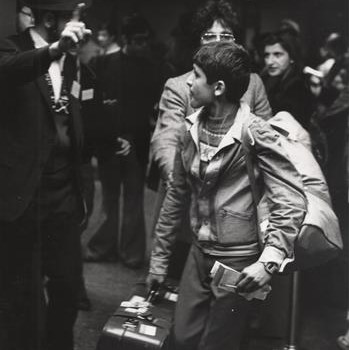
SA

Visit to Iran turns into life-saving mission
JORDAN MOSHE
“I was supposed to stay for two weeks,” Hecht, the rabbi of the Sephardic Jewish Congregation & Center of Forest Hills, Queens, told an online audience last Tuesday (16 June).
“Our message was that we came from America, were interested in the Jews of Iran, and wanted to help them strengthen their yiddishkeit. We ended up starting the process of relocating the community to America.”
Hecht played a leading role in Operation Exodus, a Chabad effort to assist the Jews of Iran, and get them safely to the United States. From 1978 to 1980, the operation successfully brought hundreds of Iranian Jewish children to the US.
The process began in August 1978 when Hecht and Rabbi Hertzel Illulian visited Tehran to establish a connection between Chabad and the Iranian Jewish community.
“In 1978, the Iranian Jewish community was successful and wealthy,” recounted Hecht. “Many Jews had become prominent, and often rabbis came to Tehran to raise money. People thought that was what we came for, but our aim was to strengthen them.”
At that time, the Jewish community of Iran could trace its history back more than 2 500 years. The destruction of the first temple and subsequent exile of the Jewish people at the hands of the Babylonian empire had resulted in Jews settling in Persia (today Iran), maintaining a continuous and strong presence until Hecht arrived.
At the time, Iran was under the leadership of a king, Mohammad Reza Shah. He had come to power in the 1940s, and had helped the country modernise, making it more democratic and even giving Jews more freedom to integrate into Iranian society. He believed that Jews were central to securing Iran’s place as a first-world country, earning him the respect and even adoration of many Jews in the country.
Said Hecht, “Jews were given more freedom and discrimination eased. They entered business, and many of them entered universities as well.” Assimilation also crept into the Jewish community, causing certain lapses in observance.
The Shah faced opposition, however. Demonstrations against him had been taking place since the 1940s, and a few broke out early in 1978. However, no one believed them to be of any major consequence, so Hecht and Illulian pressed ahead with their trip.
“We met the leadership of the community, and were invited to speak in local shuls,” said Hecht. “They received us warmly, and we saw potential for Chabad to set up infrastructure there.”
However, the growing civil unrest would change their plans completely.
“All of a sudden, violence erupted across Tehran,” Hecht said. “Different forces suddenly emerged against the Shah. It was the start of a revolution, one led by socialist workers.”
State media coverage caused a stir amongst Jews, causing people to reach out to him to help them get their children out of Iran and into America. Hecht had initially offered a few places to students interested in studying in America, but the demand increased exponentially.
“They began to understand the situation could become a real, violent revolution,” said Hecht. “I returned to the US to begin arranging student visas and permits for those wanting to come.”
Hecht needed permits from institutions willing to take the students in, but found that few were eager to assist. “The list kept increasing, the number of applicants kept growing, and no educational institutions in America were willing to help,” he said.
However, with the assistance of his late father, Rabbi Jacob J. Hecht, he successfully arranged places for 30 students at Jewish institutions established by Hecht senior’s schooling network. The demand soon exceeded availability, however, leading the Hechts to make a decision that would alter the course of Jewish history.
“We reached a turning point in history for the Jews of Tehran and world Jewry,” said Hecht. “The Jewish diaspora of Persia left in droves, Jews who had lived there continuously for 2 500 years. A few thousand would end up staying, but the bulk of the community left for good.
“The Iranian Jewish community was transferred to America, and my father started that process.”
Over the coming months, Hecht and others were involved in helping hundreds of Jewish students relocate to the US. The operation had the support of leading Chabad figurehead, Rabbi Menachem Mendel Schneerson (the Lubavitcher Rebbe). As the plight of the Iranian Jewish community became increasingly desperate, more applications kept pouring in, reaching a fever pitch in late 1979, when the country was in the full grip of revolution.
Hecht recalled, “I got a phone call at 04:00 begging for more permits than we’d ever given. The man told me, ‘Rabbi Hecht, you have to send us permits. It’s terrible here. The Shah has run away, Khomeini has taken over, there’s a war with Iraq, boys are getting kidnapped for the army, and girls are afraid to go out for fear of being raped. Please do what you can so we can get our kids out of Iran.”
Hecht’s father went out of his way to bring as many of these children to America as possible, putting them up in dormitories and with Jewish families across Crown Heights in Brooklyn. Eventually, more than 1 800 Jewish youngsters were successfully extracted from Iran and made a part of American Jewry. This came at considerable financial cost for Hecht senior, but he never once waivered in his commitment. Nor did his son.
“The Rebbe wanted them to be part of a functioning Jewish community with a structured leadership,” said Hecht. “The Rebbe wanted them to be part of strong Jewish life, and we strove to give it to them.”




